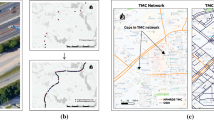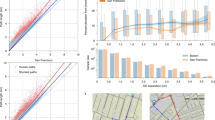Abstract
Ubiquitous taxi trajectory data has made it possible to apply it to different types of travel analysis. Of interest is the need to allow someone to monitor travel momentum and associated congestion in any location in space in real time. However, despite an abundant literature in taxi data visualization and its applicability to travel analysis, no easy method exists. To measure taxi travel momentum at a location, current methods require filtering taxi trajectories that stop at a location at a particular time range, which is computationally expensive. We propose an alternative, computationally cheaper way based on preprocessing vector fields from the trajectories. Algorithms are formalized for generating vector kernel density to estimate a travel-model-free vector field-based representation of travel momentum in an urban space. The algorithms are shared online as an open source GIS 3D extension called VectorKD. Using 17 million daily taxi GPS points within Beijing over a 4-day period, we demonstrate how to generate in real time a series of projections from a continuously updated vector field of taxi travel momentum to query a point of interest anywhere in a city, such as the CBD or the airport. This method allows a policy-maker to automatically identify temporal net influxes of travel demand to a location. The proposed methodology is shown to be over twenty times faster than a conventional selection query of trajectories. We also demonstrate, using taxi data entering the Beijing Capital International Airport and the CBD, how we can quantify in nearly real time the occurrence and magnitude of inbound or outbound queueing and congestion periods due to taxis cruising or waiting for passengers, all without having to fit any mathematical queueing model to the data.










Similar content being viewed by others
References
Angel S, Hyman G (1970) Urban velocity fields. Environ Plan 2(2):211–224
Angel S, Hyman GM (1976) Urban fields: a geometry of movement for regional science. Pion, London
Chow JYJ (2016) Dynamic UAV-based traffic monitoring under uncertainty as a stochastic arc-inventory routing policy. Int J Transp Sci Technol 5(3):167–185
Daganzo CF, Geroliminis N (2008) An analytical approximation for the macroscopic fundamental diagram of urban traffic. Transp Res Part B Methodol 42(9):771–781
DATATANG (2015) Taxi GPS location data in Beijing, China. http://www.datatang.com/data/44502. Accessed 5 Oct 2015
Geroliminis N, Daganzo CF (2008) Existence of urban-scale macroscopic fundamental diagrams: some experimental findings. Transp Res Part B Methodol 42(9):759–770
Hägerstrand T (1970) What about people in regional science? Pap Reg Sci 24(1):7–24
Huang W, Li S, Liu X, Ban Y (2015) Predicting human mobility with activity changes. Int J Geogr Inf Sci 29(9):1569–1587
Liu Y, Kang C, Gao S, Xiao Y, Tian Y (2012) Understanding intra-urban trip patterns from taxi trajectory data. J Geogr Syst 14(4):463–483
Liu X, Yan WY, Chow JYJ (2014) Time-geographic relationships between vector fields of activity patterns and transport systems. J Transp Geogr 42:22–33
Liu X, Gong L, Gong Y, Liu Y (2015) Revealing travel patterns and city structure with taxi trip data. J Transp Geogr 43:78–90
Mahmassani HS, Saberi M (2013) Urban network gridlock: theory, characteristics, and dynamics. Procedia Soc Behav Sci 80:79–98
Mao F, Ji M, Liu T (2016) Mining spatiotemporal patterns of urban dwellers from taxi trajectory data. Front Earth Sci 10(2):205–221
Miller HJ, Bridwell SA (2009) A field-based theory for time geography. Ann Assoc Am Geogr 99(1):49–75
Parsons DR, Jackson PR, Czuba JA, Engel FL, Rhoads BL, Oberg KA, Best JL, Mueller DS, Johnson KK, Riley JD (2013) Velocity Mapping Toolbox (VMT): a processing and visualization suite for moving-vessel ADCP measurements. Earth Surf Proc Land 38(11):1244–1260
Puu T, Beckmann M (1999) Continuous space modelling. In: Hall R (ed) Handbook of transportation science. Springer, Berlin, pp 269–310
Sayarshad HR, Chow JYJ (2016) Survey and empirical evaluation of nonhomogeneous arrival process models with taxi data. J Adv Transp 50(7):1275–1294
Scholz RW, Lu Y (2014) Detection of dynamic activity patterns at a collective level from large-volume trajectory data. Int J Geogr Inf Sci 28(5):946–963
Shen J, Liu X, Chen M (2017) Discovering spatial and temporal patterns from taxi-based Floating Car Data: a case study from Nanjing. GISci Remote Sens 54(5):1–22
Tang J, Liu F, Wang Y, Wang H (2015) Uncovering urban human mobility from large scale taxi GPS data. Physica A 438:140–153
Tansley S, Tolle KM (eds) (2009) The fourth paradigm: data-intensive scientific discovery, vol 1. Microsoft Research, Redmond
Toole JL, Colak S, Sturt B, Alexander LP, Evsukoff A, González MC (2015) The path most traveled: travel demand estimation using big data resources. Transp Res Part C Emerg Technol 58:162–177
Yue Y, Zhuang Y, Li Q, Mao Q (2009) Mining time-dependent attractive areas and movement patterns from taxi trajectory data. In: 2009 17th International conference on geoinformatics. IEEE, pp 1–6
Yue Y, Lan T, Yeh AG, Li QQ (2014) Zooming into individuals to understand the collective: a review of trajectory-based travel behaviour studies. Travel Behav Soc 1(2):69–78
Zheng Y, Liu Y, Yuan J, Xie X (2011) Urban computing with taxicabs. In: Proceedings of 13th international conference on ubiquitous computing, pp 89–98
Zhou Y, Fang Z, Thill JC, Li Q, Li Y (2015) Functionally critical locations in an urban transportation network: identification and space–time analysis using taxi trajectories. Comput Environ Urban Syst 52:34–47
Zhu Y, Xie K, Ozbay K, Zuo F, Yang H (2017) Data-driven spatial modeling for quantifying networkwide resilience in the aftermath of hurricanes Irene and Sandy. Transp Res Rec 2604:9–18
Acknowledgements
The authors wish to thank the DATATANG Company for the real-time GPS data used in this study. Dr. Xintao Liu acknowledges the funding support from an Area of Excellence project (1-ZE24) and a startup project (1-ZE6P). Dr. Chow is partially supported by the C2SMART Tier 1 University Transportation Center, which is gratefully acknowledged.
Author information
Authors and Affiliations
Corresponding author
Ethics declarations
Conflict of interest
The authors declare that there is no conflict of interest regarding the publication of this paper.
Rights and permissions
About this article
Cite this article
Liu, X., Chow, J.Y.J. & Li, S. Online monitoring of local taxi travel momentum and congestion effects using projections of taxi GPS-based vector fields. J Geogr Syst 20, 253–274 (2018). https://doi.org/10.1007/s10109-018-0273-6
Received:
Accepted:
Published:
Issue Date:
DOI: https://doi.org/10.1007/s10109-018-0273-6




